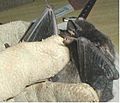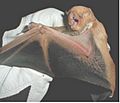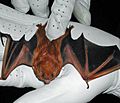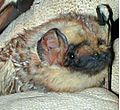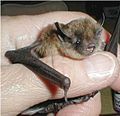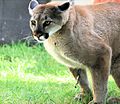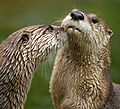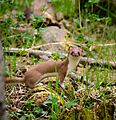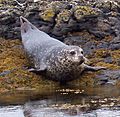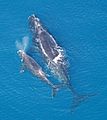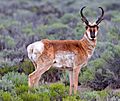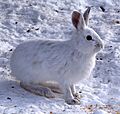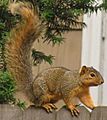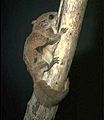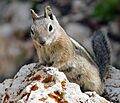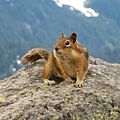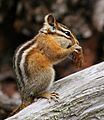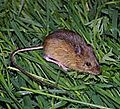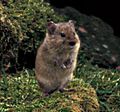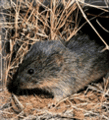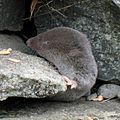List of mammals of Canada facts for kids
Canada is a huge country with many different types of land and water, from ocean coasts to tall mountains, wide plains, and even cities. This means it's home to about 200 different kinds of mammals! You can find almost half of all the known whales and dolphins here. The biggest ocean area is the Arctic Archipelago, and the largest land area is the Boreal Shield. The most common type of mammal in Canada is the rodent, while the smallest group is the opossums.
People have been studying mammals in Canada for a long time. One of the first detailed accounts was from Samuel Hearne in 1795. Later, John Richardson wrote an important book in 1829 called Fauna Boreali-Americana. Joseph Burr Tyrrell tried to make a full list of Canadian mammals in 1888. Other important naturalists included Ernest Thompson Seton and Charles-Eusèbe Dionne. Today, you can read about Canadian mammals in magazines like The Canadian Field-Naturalist and the Canadian Journal of Zoology.
Some Canadian mammals are very special symbols. The Canadian horse and the North American beaver are official symbols of Canada. Many provinces also have their own special animal symbols.
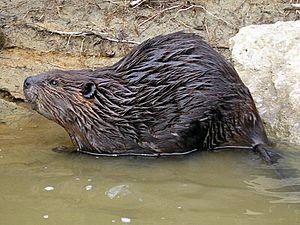
Contents
What do animal statuses mean?
When we talk about how animals are doing, we often use the IUCN Red List of Threatened Species. This list helps us understand if an animal is safe or if it needs our help. Here's what the different levels mean:
- Extinct: This animal is gone forever.
- Extinct in the Wild: This animal only lives in zoos or special places, not in nature.
- Critically Endangered: This animal is in extreme danger of disappearing very soon.
- Endangered: This animal is in high danger of disappearing.
- Vulnerable: This animal is likely to become endangered if we don't help it.
- Near Threatened: This animal might become vulnerable soon.
- Least Concern: This animal is doing well and is not in danger right now.
- Data Deficient: We don't have enough information to know how this animal is doing.
- Not Evaluated: This animal hasn't been checked yet.
(The information below is from March 5, 2014)
Mammals Living in Canada
Bats: Flying Mammals
Bats are amazing because they are the only mammals that can truly fly! Their front legs have become wings. About 20% of all mammal species are bats.
| Common Name (French Name) |
Species | Where it Lives | Where it's Found in Canada | Status |
|---|---|---|---|---|
| Family Vespertilionidae: Vesper Bats | ||||
| Pallid bat (Chauve-souris blonde) |
Antrozous pallidus | Dry plains | British Columbia |
|
| Townsend's big-eared bat (Oreillard de Townsend) |
Corynorhinus townsendii | Open woodlands | Southern British Columbia |
|
| Big brown bat (Grande chauve-souris brune) |
Eptesicus fuscus | Many places, including cities | British Columbia to southern Quebec and New Brunswick |
|
| Spotted bat (Oreillard maculé) |
Euderma maculatum | Near water | Inner British Columbia |
|
| Silver-haired bat (Chauve-souris argentée) |
Lasionycteris noctivagans | Forest lakes | Most of southern Canada |
|
| Western red bat (Chauve-souris rousse de l'Ouest) |
Lasiurus blossevillii | Open areas and cities | Southwestern British Columbia |
|
| Eastern red bat (Chauve-souris rousse de l'Est) |
Lasiurus borealis | Open areas and cities | Alberta to southern Maritimes |
|
| Hoary bat (Chauve-souris cendré) |
Lasiurus cinereus | Forests | British Columbia to northern Hudson Bay and Maritimes |
|
| California myotis (Chauve-souris de Californie) |
Myotis californicus | West Coast forest | West Coast and Okanagan Valley |
|
| Western small-footed myotis (Chauve-souris pygmée de l'Ouest) |
Myotis ciliolabrum | Dry areas | Southern Alberta and Saskatchewan |
|
| Long-eared myotis (Chauve-souris à longues oreilles) |
Myotis evotis | Varied | Southern British Columbia, Alberta and Saskatchewan |
|
| Keen's myotis (Chauve-souris de Keen) |
Myotis keenii | Forests | West Coast |
|
| Eastern small-footed myotis (Chauve-souris pygmée de l'Est) |
Myotis leibii | Mountain forest | Southern Ontario, southwestern Quebec |
|
| Little brown bat (Petite chauve-souris brune) |
Myotis lucifugus | Many places, including cities | Yukon to Atlantic Canada |
|
| Northern long-eared myotis (Vespertilion nordique or Chauve-souris nordique) |
Myotis septentrionalis | Forests | Central to Eastern Canada |
|
| Fringed myotis (Chauve-souris à queue frangée) |
Myotis thysanodes | White pine forest | Southcentral British Columbia |
|
| Long-legged myotis (Chauve-souris à longues pattes) |
Myotis volans | Varied | British Columbia and Alberta |
|
| Yuma myotis (Chauve-souris de Yuma) |
Myotis yumanensis | Open areas | West Coast and Okanagan Valley |
|
| Tri-colored bat (Pipistrelle de l'Est) |
Pipistrellus subflavus | Forest, fields and waterways | Southern Ontario, Quebec and Maritimes |
|
Carnivores: Meat Eaters
Carnivorans are a group of over 260 species, and most of them eat meat. They have special teeth and skull shapes for eating meat.
| Common Name (French Name) |
Species | Where it Lives | Where it's Found in Canada | Status |
|---|---|---|---|---|
| Family Felidae: Cats | ||||
| Canada lynx (Lynx du Canada) |
Lynx canadensis | Forests | Most of Canada |
|
| Bobcat (Lynx roux) |
Lynx rufus | Varied | Southern Canada |
|
| Cougar (Puma) |
Puma concolor | Mountains, marshes, dense forest | Mountainous regions of Alberta, British Columbia, and the Yukon |
|
| Family Canidae: Dogs | ||||
| Coyote (Coyote) |
Canis latrans | Varied | Rocky Mountains, southern Prairies, southern Ontario, Quebec, and Maritime provinces |
|
| Grey wolf (Loup) |
Canis lupus | Varied | All of Canada, except Anticosti and Prince Edward Island. Arctic wolves live in Northern Canada. |
|
| Eastern wolf (Loup oriental) |
Canis lycaon | Varied | Great Lakes region in southeastern Canada (Manitoba, Ontario, Quebec) |
|
| Red wolf (Loup rouge) |
Canis rufus | Varied | Used to live in Ontario; now gone from Canada. |
|
| Arctic fox (Renard arctique or polaire) |
Vulpes lagopus | Tundra | Northern Canada |
|
| Swift fox (Renard véloce) |
Vulpes velox | Desert and dry prairie | Southern Prairie Provinces |
|
| Red fox (Renard roux) |
Vulpes vulpes | Varied | All of Canada except parts of the Arctic Islands and West Coast |
|
| Family Ursidae: Bears | ||||
| Black bear (Ours noir) |
Ursus americanus | Varied, mostly forested areas | Most of Canada except Arctic and Prince Edward Island |
|
| Grizzly bear (Ours brun) |
Ursus arctos horribilis | Open spaces, mostly alpine and Arctic tundra | Yukon, most of British Columbia, Rocky Mountains, Northwest Territory and Nunavut |
|
| Polar bear (Ours blanc or polaire) |
Ursus maritimus | Edge of ice fields | Arctic Sea and coasts |
|
| Family Procyonidae: Raccoons and Relatives | ||||
| Raccoon (Raton laveur) |
Procyon lotor | Forests near water | Southern Canada except Rockies |
|
| Family Mustelidae: Weasels and Otters | ||||
| Sea otter (Loutre de mer) |
Enhydra lutris | Sea and coast | Vancouver and Goose Island coast |
|
| Northern river otter (Loutre de rivière) |
Lontra canadensis | Rivers, lakes and swamps | Most of Canada except parts of the Arctic and southern Prairies |
|
| Wolverine (Carcajou) |
Gulo gulo | Boreal forest, Arctic tundra | Much of continental Canada and the Arctic islands |
|
| American marten (Martre d'Amérique) |
Martes americana | Coniferous and mixed forests | Rockies to Labrador and Newfoundland, except Prairies |
|
| Pacific marten (Martre du Pacifique) |
Martes caurina | Coniferous and mixed forests | West coast up to Yukon down to British Columbia and the Rockies |
|
| Beringian ermine (Hermine béringienne) |
Mustela erminea | Boreal forest, Arctic tundra | Most of Arctic Canada |
|
| Haida ermine (Hermine Haïda) |
Mustela haidarum | Temperate rainforest | Haida Gwaii archipelago |
|
| Black-footed ferret (Putois à pieds noirs) |
Mustela nigripes | Prairies and grasslands | Used to live in southern Alberta and Saskatchewan, now gone. |
*I: Endangered
|
| Least weasel (Belette pygmée) |
Mustela nivalis | Varied | Yukon to Labrador, except southern Quebec and Ontario |
|
| American ermine (Hermine américaine) |
Mustela richardsonii | Varied | Almost all of Canada south of the Arctic |
|
| Long-tailed weasel (Belette à longue queue) |
Neogale frenata | Open areas | Southern Rockies to western Ontario, southern Ontario to western Nova Scotia |
|
| Mink (Vison d'Amérique) |
Neogale vison | Wetlands and rivers | Most of Canada, except the Arctic, parts of the Prairies and Anticosti Island |
|
| Fisher (Pékan) |
Pekania pennanti | Coniferous and mixed forests near rivers | British Columbia to central Quebec |
|
| Badger (Blaireau d'Amérique) |
Taxidea taxus | Fields | Southern Prairies, south-central British Columbia and southernmost Ontario |
|
| Family Mephitidae: Skunks | ||||
| Striped skunk (Moufette rayée) |
Mephitis mephitis | Forests, farms, valleys | Rockies to the Maritimes |
|
| Western spotted skunk (Moufette tachetée occidentale) |
Spilogale gracilis | Thickets and bushes | Southwestern British Columbia |
|
| Superfamily Pinnipedia: Seals and Walruses | ||||
| Family Otariidae: Eared Seals | ||||
| Northern fur seal (Otarie à fourrure) |
Callorhinus ursinus | Sea, rocky coasts | Off the coast of British Columbia |
|
| Steller sea lion (Otarie de Steller) |
Eumetopias jubatus | Coast waters, rocky areas | British Columbia |
|
| Walrus (Morse) |
Odobenus rosmarus | Arctic shallow waters | James Bay to Greenland |
|
| California sea lion (Otarie de Californie) |
Zalophus californianus | Coast waters | Near Vancouver Island |
|
| Family Phocidae: Earless Seals | ||||
| Hooded seal (Phoque à capuchon) |
Cystophora cristata | Sea | Atlantic from Gulf of the Saint Lawrence to northern Baffin Island |
|
| Bearded seal (Phoque barbu) |
Erignathus barbatus | Sea | Arctic Ocean |
|
| Grey seal (Phoque gris) |
Halichoerus grypus | Sea rocks, and reefs | East Coast |
|
| Northern elephant seal (Éléphant de mer du Nord) |
Mirounga angustirostris | Tropical and temperate sea waters | Sometimes seen in British Columbia |
|
| Harp seal (Phoque du Groenland) |
Phoca groenlandica | Cold waters | Gulf of Saint Lawrence to James Bay and Greenland |
|
| Harbour seal (Phoque commun) |
Phoca vitulina | Coast waters and some inland lakes | Most Canadian coasts except the colder Arctic |
|
| Ringed seal (Phoque annelé) |
Pusa hispida | Arctic waters and ice | Arctic Ocean |
|
Cetaceans: Whales, Dolphins, and Porpoises
Cetaceans are mammals that live completely in the water. They have a smooth body, almost no hair, and a thick layer of blubber to keep them warm. Their front fins and tail help them move through the water.
| Common Name (French Name) |
Species | Where it Lives | Where it's Found in Canada | Status |
|---|---|---|---|---|
| Family Balaenidae: Right Whales | ||||
| Bowhead whale (Baleine boréale) |
Balaena mysticetus | Polar ice in winter, coastal waters in summer | Arctic Ocean |
|
| North Atlantic right whale (Baleine franche) |
Eubalaena glacialis | Temperate coast waters | North Atlantic |
|
| North Pacific right whale (Baleine franche) |
Eubalaena japonica | North Pacific |
|
|
| Family Balaenopteridae: Rorquals | ||||
| Northern minke whale (Petit rorqual) |
Balaenoptera acutorostrata | Temperate or polar seas | Northern Atlantic and Pacific |
|
| Sei whale (Rorqual boréal) |
Balaenoptera borealis | Temperate seas | Atlantic and Pacific oceans |
|
| Blue whale (Rorqual bleu) |
Balaenoptera musculus | Temperate and polar waters | Atlantic and Pacific oceans |
|
| Fin whale (Rorqual commun) |
Balaenoptera physalus | Open ocean, coastal | Atlantic and Pacific oceans |
|
| Humpback whale (Baleine à bosse) |
Megaptera novaeangliae | Coastal waters, often in river mouths | Atlantic and Pacific oceans |
|
| Family Eschrichtiidae: Grey Whale | ||||
| Grey whale (Baleine grise) |
Eschrichtius robustus | Temperate continental shelf waters | Pacific Coast |
|
| Family Monodontidae: Narwhal and Beluga | ||||
| Narwhal (Narval) |
Monodon monoceros | Edge of Arctic ice sheet | Eastern Arctic Ocean |
|
| Beluga (Bélouga) |
Delphinapterus leucas | Arctic coast waters, often swims up rivers | Eastern and Western Arctic Ocean |
|
| Family Phocoenidae: Porpoises | ||||
| Harbour porpoise (Marsouin commun) |
Phocoena phocoena | East and West Coast |
|
|
| Dall's porpoise (Marsouin de Dall) |
Phocoenoides dalli | Continental shelf | North Pacific |
|
| Family Physeteridae: Sperm Whale | ||||
| Sperm whale (Cachalot) |
Physeter macrocephalus | Very deep waters | Pacific and Atlantic Oceans (only migrating males in Canadian waters) |
|
| Family Ziphidae: Beaked Whales | ||||
| Cuvier's beaked whale (Baleine à bec de Cuvier) |
Ziphius cavirostris | Uncertain | North Pacific and Atlantic |
|
| Baird's beaked whale (Grande baleine à bec) |
Berardius bairdii | Near continental shelf cliffs | North Pacific |
|
| Northern bottlenose whale (Baleine à bec commune) |
Hyperoodon ampullatus | Subarctic waters | North Atlantic and part of Arctic |
|
| Sowerby's beaked whale (Baleine à bec de Sowerby) |
Mesoplodon bidens | Deep ocean | Temperate North Atlantic |
|
| Hubbs' beaked whale (Baleine à bec de Moore) |
Mesoplodon carlhubbsi | Temperate waters | North Pacific |
|
| Stejneger's beaked whale (Baleine à bec de Stejneger) |
Mesoplodon stejnegeri | Cold, high sea | North Pacific |
|
| Family Delphinidae: Oceanic Dolphins | ||||
| White-beaked dolphin (Dauphin à bec blanc) |
Lagenorhynchus albirostris | High, cold sea | North Atlantic |
|
| Atlantic white-sided dolphin (Dauphin à flancs blancs) |
Leucopleurus acutus | Temperate high sea | North Atlantic |
|
| Common bottlenose dolphin (Grand dauphin) |
Tursiops truncatus | Coastal waters | Sometimes seen in the Maritimes |
|
| Short-beaked common dolphin (Dauphin commun à bec court) |
Delphinus delphis | Temperate high sea | Atlantic and Pacific Continental shelves |
|
| Pacific white-sided dolphin (Dauphin à flancs blancs du pacifique) |
Sagmatias obliquidens | Temperate and subarctic seas | North Pacific |
|
| Orca (Épaulard or orque) |
Orcinus orca | Prefers coastal waters | Atlantic, Pacific and parts of the Arctic |
|
| Short-finned pilot whale (Globicéphale du Pacifique) |
Globicephala macrorhynchus | Varied | Pacific Ocean |
|
| Long-finned pilot whale (Globicéphale de l'Atlantique) |
Globicephala melas | Varied | North Atlantic |
|
Even-Toed Ungulates: Hoofed Animals
Even-toed ungulates are animals with hooves that have an even number of toes (like two or four). Their weight is spread evenly on their third and fourth toes. There are about 220 species worldwide, and many are very important to humans.
| Common Name (French Name) |
Species | Where it Lives | Where it's Found in Canada | Status |
|---|---|---|---|---|
| Family Cervidae: Deer | ||||
| Moose (Original) |
Alces alces | Subarctic and open forests | Yukon to New Brunswick |
|
| Elk (Wapiti) |
Cervus canadensis | Varied, prefers open areas | Southern Rockies and parts of the Prairies |
|
| Mule deer (Cerf mulet) |
Odocoileus hemionus | Subarctic and open forests | West Coast to Prairies |
|
| White-tailed deer (Cerf de Virginie) |
Odocoileus virginianus | Valleys, rivers, marshes, forest edges | Southern Rockies and Prairie Provinces to Labrador and Maritimes |
|
| Caribou (Caribou) |
Rangifer tarandus | Tundra, Taiga and boreal forest | Boreal forest across Canada, and parts of the Arctic and Rockies |
|
| Family Antilocapridae: The Pronghorn | ||||
| Pronghorn (Antilope d'Amérique or pronghorn) |
Antilocapra americana | Prairies and plains | Southern Saskatchewan and Alberta |
|
| Family Bovidae: Bovids | ||||
| American bison (Bison) |
Bison bison | Varied | South of the Great Slaves Lake |
|
| Mountain goat (Chèvre de montagne) |
Oreamnos americanus | Mountains | Various parts of the Western Cordillera |
|
| Muskox (Boeuf musqué) |
Ovibos moschatus | Arctic tundra | Canadian Arctic |
|
| Bighorn sheep (Mouflon d'Amérique) |
Ovis canadensis | Alpine prairies | South and southeastern Rockies |
|
| Dall sheep (Mouflon de Dall) |
Ovis dalli | Alpine tundra | Yukon and northern British Columbia |
|
Marsupials: Pouch Mammals
Didelphimorphia is the group of common opossums found in the Americas. They are small to medium-sized mammals, about the size of a large house cat, with a long nose and a tail that can grip things.
| Common Name (French Name) |
Species | Where it Lives | Where it's Found in Canada | Status |
|---|---|---|---|---|
| Family Didelphidae: New World Opossums | ||||
| Virginia opossum (Opossum d'Amérique or de Virginie) |
Didelphis virginiana | Humid lowland forest | Southwestern Ontario, introduced in British Columbia |
|
Rabbits, Hares, and Pikas
The lagomorphs include two families: Leporidae (hares and rabbits) and Ochotonidae (pikas). They might look like rodents, but they have four front teeth in their upper jaw instead of two.
| Common Name
(French Name) |
Species | Where it Lives | Where it's Found in Canada | Status |
|---|---|---|---|---|
| Family Ochotonidae: Pikas | ||||
| Collared pika (Pica à collier) |
Ochotona collaris | Mountains above the tree line | Rockies of the Yukon |
|
| American pika (Pica d'Amérique) |
Ochotona princeps | Mountains near the tree line | Southern British Columbia and Alberta |
|
| Family Leporidae: Rabbits and Hares | ||||
| Snowshoe hare (Lièvre d'Amérique) |
Lepus americanus | Forests | Much of mainland Canada except southernmost Ontario |
|
| Arctic hare (Lièvre arctique) |
Lepus arcticus | Tundra | Canadian Arctic (including Arctic Archipelago), Labrador, Newfoundland |
|
| White-tailed jackrabbit (Lièvre de Townsend) |
Lepus townsendii | Fields | Southern Prairies, Okanagan Valley |
|
| Eastern cottontail (Lapin à queue blanche) |
Sylvilagus floridanus | Open woodlands | Southern Manitoba, Saskatchewan Ontario and Quebec |
|
| Mountain cottontail (Lapin de Nuttall) |
Sylvilagus nuttallii | Dry plains | Southern Alberta and Saskatchewan, Okanagan and Similkameen valleys |
|
| New England cottontail (Lapin de Nouvelle-Angleterre) |
Sylvilagus transitionalis | High elevation forests | Possibly in Quebec |
|
Rodents: Gnawing Mammals
Rodents are the largest group of mammals, making up over 40% of all mammal species! They have two front teeth in their upper and lower jaws that never stop growing. They have to keep gnawing to keep their teeth short. Most rodents are small, but some, like the capybara from South America, can weigh up to 45 kg (100 lb).
| Common Name
(French Name) |
Species | Where it Lives | Where it's Found in Canada | Status |
|---|---|---|---|---|
| Family Erethizontidae: New World Porcupines | ||||
| North American porcupine (Porc-épic d'Amérique) |
Erethizon dorsatum | Forests south of the tree line | All of Canada except Arctic | |
| Family Aplodontiidae: Mountain Beaver | ||||
| Mountain beaver (Castor de montagne) |
Aplodontia rufa | Mountain forest | Southern British Columbia |
|
| Family Castoridae: Beavers | ||||
| North American beaver (Castor) |
Castor canadensis | Wet areas of forests | All of Canada below the tree line except drier parts of the Prairies |
|
| Family Sciuridae: Squirrels | ||||
| Eastern grey squirrel (Écureuil gris) |
Sciurus carolinensis | Prefers deep forest, but often in cities | Southern Manitoba and northwestern Ontario, southern Quebec, Ontario and New Brunswick |
|
| Eastern fox squirrel (Écureuil fauve) |
Sciurus niger | Edges of forests and groves | Southern Manitoba and Saskatchewan, British Columbia and Pelee Island |
|
| Douglas squirrel (Écureuil de Douglas) |
Tamiasciurus douglasii | Coniferous forest | Southwestern British Columbia |
|
| American red squirrel (Écureuil roux) |
Tamiasciurus hudsonicus | Forests | Mainland Canada south of the tree line, except southern Prairies and southwestern British Columbia; Vancouver Island |
|
| Humboldt's flying squirrel | Glaucomys oregonensis | Boreal forest | Southern British Columbia |
|
| Northern flying squirrel (Grand polatouche) |
Glaucomys sabrinus | Boreal forest | Mainland Canada south of the tree line except southern Prairies |
|
| Southern flying squirrel (Petit polatouche) |
Glaucomys volans | Deciduous forest | Southern Ontario, parts of Quebec, southern Nova Scotia |
|
| Black-tailed prairie dog (Chien de prairie à queue noire) |
Cynomys ludovicianus | Dry prairies | Small part of southern Saskatchewan |
|
| Hoary marmot (Marmotte des Rocheuses) |
Marmota caligata | Alpine tundra | Rockies, Columbia, and Coast Mountains |
|
| Yellow-bellied marmot (Marmotte à ventre jaune) |
Marmota flaviventris | Mountains | Central British Columbia and southernmost Alberta |
|
| Groundhog (Marmotte commune, siffleux) |
Marmota monax | Broken ground | Much of mainland Canada east of the Rockies, inland valleys and parts of western Yukon |
|
| Vancouver Island marmot (Marmotte de Vancouver) |
Marmota vancouverensis | Near the mountain tree line | Only found on Vancouver Island |
|
| Golden-mantled ground squirrel (Spermophile à mante dorée) |
Callospermophilus lateralis | Mountain coniferous forest | Southeastern Rockies |
|
| Cascade golden-mantled ground squirrel (Spermophile à mante dorée des Cascades) |
Callospermophilus saturatus | Southern British Columbia Cascade Range | British Columbia |
|
| Franklin's ground squirrel (Écureuil terrestre de Franklin) |
Poliocitellus franklinii | Parklands | Northwestern Ontario and southern Prairies | |
| Thirteen-lined ground squirrel (Spermophile rayé) |
Ictidomys tridecemlineatus | Groves, swamps, uncultivated land | Southern Prairie Provinces |
|
| Columbian ground squirrel (Spermophile du Columbia) |
Urocitellus columbianus | Mountain open areas | Southern Rocky mountains |
|
| Arctic ground squirrel (Spermophile arctique) |
Urocitellus parryii | Tundra without permafrost | Mainland Arctic |
|
| Richardson's ground squirrel (Spermophile de Richardson) |
Urocitellus richardsonii | Prairies | South of the Prairie provinces |
|
| Yellow-pine chipmunk (Tamia amène) |
Tamias amoenus | Dry mountain forest | Southern and central British Columbia and Alberta |
|
| Least chipmunk (Tamia mineur) |
Tamias minimus | Edges of forests, groves, but also open spaces | Western Quebec to Yukon |
|
| Red-tailed chipmunk (Tamia à queue rousse) |
Tamias ruficaudus | High altitude forest and valley pine groves | Southern British Columbia and Alberta |
|
| Eastern chipmunk (Tamia rayé, Petit suisse) |
Tamias striatus | Deciduous forest | Maritime provinces, and the southern half of Quebec, Ontario, and Manitoba |
|
| Townsend's chipmunk (Tamia de Townsend) |
Tamias townsendii | Western Coast lowland and mountain forests | Southwestern British Columbia |
|
| Family Geomyidae: Pocket Gophers | ||||
| Plains pocket gopher (Gaufre brun) |
Geomys bursarius | Fields and banks | Southern Manitoba |
|
| Northern pocket gopher (Gaufre gris) |
Thomomys talpoides | Open areas | Southern Prairie Provinces and British Columbia |
|
| Family Heteromyidae: Pocket Mice and Kangaroo Rats | ||||
| Ord's kangaroo rat (Rat-kangourou d'Ord) |
Dipodomys ordii | Semi-desert areas | Great Sand Hills area |
|
| Olive-backed pocket mouse (Souris à abajoues des plaines) |
Perognathus fasciatus | Dry plains | Southern Prairies |
|
| Great Basin pocket mouse (Souris à abajoues des pinèdes) |
Perognathus parvus | Dry plains | Great Basin |
|
| Family Dipodidae: Jumping Mice | ||||
| Woodland jumping mouse (Souris sauteuse des bois) |
Napaeozapus insignis | Forest streams | Eastern Canada |
|
| Meadow jumping mouse (Souris sauteuse des champs) |
Zapus hudsonius | Wet fields | Eastern Canada to Yukon |
|
| Western jumping mouse (Souris sauteuse de l'ouest) |
Zapus princeps | Prairies | Rockies and Prairies |
|
| Pacific jumping mouse (Souris sauteuse du Pacifique) |
Zapus trinotatus | Mountain prairies | Southwestern British Columbia |
|
| Family Cricetidae: Voles, Lemmings, and Mice | ||||
| Southern red-backed vole (Campagnol à dos roux de Gapper) |
Myodes gapperi | Forests | Most of the provinces, except Newfoundland and Vancouver Island |
|
| Northern red-backed vole (Campagnol à dos roux boréal) |
Myodes rutilus | Shrubby tundra | Mainland Arctic |
|
| Northern collared lemming (Lemming variable or lemming à collerette) |
Dicrostonyx groenlandicus | Tundra | Northern Arctic islands |
|
| Ungava collared lemming (Lemming d'Ungava) |
Dicrostonyx hudsonius | Tundra | Northern Quebec |
|
| Victoria collared lemming (Lemming à collerette) |
Dicrostonyx kilangmiutak | Tundra | Mainland Arctic, Banks, Victoria and King Williams Islands |
|
| Ogilvie Mountains collared lemming (—) |
Dicrostonyx nunatakensis | Mountain tundra | Ogilvie Mountains | |
| Richardson's collared lemming (—) |
Dicrostonyx richardsoni | Tundra | Arctic, roughly south of the Thelon River Basin |
|
| Sagebrush vole (Campagnol des sauges) |
Lemmiscus curtatus | Sagebrush steppes | Southern Alberta and Saskatchewan |
|
| North American brown lemming (Lemming brun) |
Lemmus trimucronatus | Tundra of Nunavut, Northwest Territories and Yukon, also west coast of British Columbia |
|
|
| Rock vole (Campagnol des rochers) |
Microtus chrotorrhinus | Rocky areas | Boreal Ontario and Quebec; southernmost Labrador; Gaspesia and northern New Brunswick |
|
| Long-tailed vole (Campagnol longicaude) |
Microtus longicaudus | Varied | Western Cordillera |
|
| Singing vole (Campagnol chanteur) |
Microtus miurus | Alpine tundra | Yukon and neighbouring Northwest Territory |
|
| Montane vole (Campagnol montagnard) |
Microtus montanus | Shortgrass alpine prairies | Central south British Columbia |
|
| Prairie vole (Campagnol des prairies) |
Microtus ochrogaster | Prairies | Prairie provinces |
|
| Tundra vole (Campagnol nordique) |
Microtus oeconomus | Wet tundra | Western Arctic |
|
| Creeping vole (Campagnol de l'oregon) |
Microtus oregoni | Humid coniferous forest | Southern British Columbia |
|
| Meadow vole (Campagnol des champs) |
Microtus pennsylvanicus | Wet fields | All of Canada except Arctic and westernmost ranges |
|
| Woodland vole (Campagnol sylvestre) |
Microtus pinetorum | Deciduous forest | Southernmost Ontario and Quebec |
|
| Water vole (Campagnol de Richardson) |
Microtus richardsoni | Alpine prairies and streams | Cascades and southern Rockies |
|
| Townsend's vole (Campagnol de Townsend) |
Microtus townsendii | Salty marshes and fields | Vancouver Island, nearby islands and Fraser River delta |
|
| Taiga vole (Campagnol à joues jaunes) |
Microtus xanthognathus | Forest streams | From southwestern Hudson Bay through northern Prairies and Yukon |
|
| Muskrat (Rat musqué) |
Ondatra zibethicus | Wetlands | Most of Canada outside the Arctic and southwestern British Columbia |
|
| Western heather vole (Campagnol des bruyères) |
Phenacomys intermedius | Varied | British Columbia |
|
| Eastern heather vole (Phénacomys d'Ungava) |
Phenacomys ungava | Varied | Quebec, Ontario and Labrador to southern Yukon |
|
| Northern bog lemming (Campagnol-lemming boréal) |
Synaptomys borealis | Peatlands | Labrador to Alaska; Gaspesia and northern New Brunswick |
|
| Southern bog lemming (Campagnol-lemming de Cooper) |
Synaptomys cooperi | Peatlands | Western Manitoba, central and southern Ontario and Quebec, New Brunswick, Nova Scotia |
|
| Bushy-tailed woodrat (Rat à queue touffue) |
Neotoma cinerea | Mountains | Western Cordillera |
|
| Yukon deer mouse (Souris de yukon) |
Peromyscus arcticus | Forest, mountains | Yukon |
|
| Northwestern deer mouse (Souris de keen) |
Peromyscus keeni | Mild and rainy forest | West of the Coastal Mountains |
|
| White-footed mouse (Souris à pattes blanches) |
Peromyscus leucopus | Deciduous forest | Southern Alberta, Saskatchewan, Ontario, Quebec and Nova Scotia |
|
| Eastern deer mouse (Souris sylvestre) |
Peromyscus maniculatus | Anywhere except wetlands | Easternmost Saskatchewan to most of eastern Canada |
|
| Western deer mouse (Souris sylvestre) |
Peromyscus sonoriensis | Anywhere except wetlands | Saskatchewan west to British Columbia, north to the southern Northwest Territories and eastern Yukon |
|
| Western harvest mouse (Souris-moissonneuse occidentale) |
Reithrodontomys megalotis | Prairies | Okanagan Valley, south of Alberta and Saskatchewan |
|
| Northern grasshopper mouse (Souris à sauterelles) |
Onychomys leucogaster | Southern Prairies | Prairies |
|
Shrews and Moles: Insect Eaters
Eulipotyphlans are mammals that mostly eat insects. Shrews look a lot like mice, while moles are strong diggers that live underground.
| Common Name
(French Name) |
Species | Where it Lives | Where it's Found in Canada | Status |
|---|---|---|---|---|
| Family Soricidae: Shrews | ||||
| Northern short-tailed shrew (Grande musaraigne) |
Blarina brevicauda | Deciduous forest | Eastern Saskatchewan to Maritime provinces |
|
| North American least shrew (Petite musaraigne) |
Cryptotis parva | Fields, clearings and salt marshes | Long Point, Ontario |
|
| Arctic shrew (Musaraigne arctique) |
Sorex arcticus | Peatlands and marshes | From the Northwest Territory to central Quebec |
|
| Maritime shrew (Musaraigne des Maritimes) |
Sorex maritimensis | Peatlands and marshes | New Brunswick and Nova Scotia |
|
| Marsh shrew (Musaraigne de Bendire) |
Sorex bendirii | Coniferous forest | Fraser Valley |
|
| Masked shrew (Musaraigne cendrée) |
Sorex cinereus | Varied | Most of Mainland Canada except northernmost Quebec; Prince Edward and Cape Breton islands |
|
| Long-tailed shrew (Musaraigne longicaude) |
Sorex dispar | Wet banks | New Brunswick |
|
| Smoky shrew (Musaraigne fuligineuse) |
Sorex fumeus | Deciduous forest | Great lakes to Maritimes |
|
| Gaspé shrew (Musaraigne de Gaspé) |
Sorex gaspensis | Near forest streams | Gaspesia and northern New Brunswick; Cape Breton Island |
|
| Prairie shrew (Musaraigne des steppes) |
Sorex haydeni | Grassland | Southern Prairies |
|
| American pygmy shrew (Musaraigne pygmée) |
Sorex hoyi | Forest clearings | Yukon and eastern Cordillera to Labrador and Maritimes |
|
| Merriam's shrew (Musaraigne de Merriam) |
Sorex merriami | Grasslands | Extreme southern British Columbia |
|
| Montane shrew (Musaraigne sombre) |
Sorex monticolus | Mountain streams and marshes | Western Cordillera |
|
| American water shrew (Musaraigne palustre) |
Sorex palustris | Lakes and marshes | Western Cordillera to Labrador and Maritimes except southern Prairies and southernmost Ontario |
|
| Preble's shrew (Musaraigne de Preble) |
Sorex preblei | Mountain streams and marshes | Southcentral British Columbia |
|
| Trowbridge's shrew (Musaraigne de Trowbridge) |
Sorex trowbridgii | Coniferous forest | Lower Fraser Valley |
|
| Tundra shrew (—) |
Sorex tundrensis | Tundra | Yukon and Northwest territory |
|
| Barren ground shrew (—) |
Sorex ugyunak | Tundra | Mainland Arctic |
|
| Vagrant shrew (Musaraigne errante) |
Sorex vagrans | Mountain streams | Southern Cordillera |
|
| Family Talpidae: Moles | ||||
| Star-nosed mole (Condylure étoilé) |
Condylura cristata | Wet forest | Manitoba, Ontario, Quebec, Labrador, New Brunswick and Nova Scotia |
|
| Coast mole (Taupe du Pacifique) |
Scapanus orarius | Alpine coniferous forest | Southwestern British Columbia |
|
| Townsend's mole (Taupe de Townsend) |
Scapanus townsendii | Fields | Southwestern British Columbia |
|
| Shrew-mole (Taupe de Townsend) |
Neurotrichus gibbsii | Banks | Southwestern British Columbia |
|
| Eastern mole (Taupe à queue glabre) |
Scalopus aquaticus | Open woodlands | Point Pelee area |
|
| Hairy-tailed mole (Taupe à queue velue) |
Parascalops breweri | Dry loose soils | Southern Quebec and Ontario |
|
Animals That Are New to Canada
Some wild mammals found in Canada were not originally from here. Some were brought here on purpose or by accident. These include the house mouse (Mus musculus), and brown and black rats (Rattus norvegicus and R. rattus). Other animals like the coypu (Myocastor coypus), European rabbit (Oryctolagus cuniculus), and European hare (Lepus europaeus) escaped from captivity. The European fallow deer (Dama dama) and wild boar (Sus scrofa) were brought in for hunting.
Other animals are seen in Canada only by chance, or so rarely that we don't know if they live here permanently. Most of these are whales and dolphins that are not well known. Some bats, like the big free-tailed bat (Nyctinomops macrotis) and evening bat (Nycticeius humeralis), are mostly found south of Canada but sometimes cross the border. The New England cottontail (Sylvilagus transitionalis) is also usually found in the US but might sometimes be in Canada.
Animals That Have Disappeared or Returned
In recorded history, three mammal species disappeared from Canada, but two of them have been brought back!
The sea mink (Neogale macrodon) used to live in the Maritime Provinces. Sadly, it became extinct because too many were hunted, and their homes were destroyed. The last known sea mink was caught in New Brunswick in 1894.
The eastern elk (Cervus canadensis canadensis), a type of elk, also used to live in Quebec and Ontario. It disappeared for similar reasons as the sea mink.
Eastern cougars (Puma concolor couguar) also lived in the eastern provinces but disappeared after their populations in the United States were wiped out.
The black-footed ferret (Mustela nigripes) disappeared from Canada in 1937. People thought it was completely gone until a wild group was found in Wyoming in 1981. Efforts to bring them back to Canada have not worked yet.
The swift fox (Vulpes velox) and sea otter (Enhydra lutris) both disappeared from Canada in the 1930s. But good news! They were successfully brought back in the early 1970s.
Images for kids
See also
- Fauna of Canada
- List of mammals of the United States
- List of mammals of North America
- Lists of mammals by region
- List of prehistoric mammals



